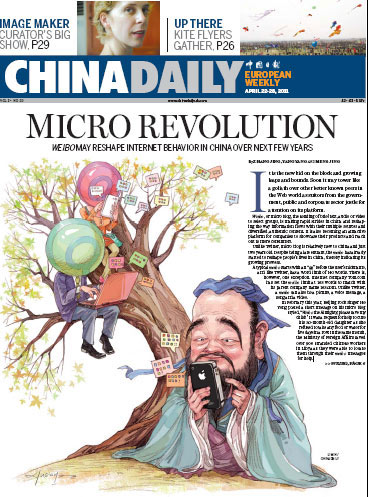Handle platform with kid gloves
Updated: 2011-04-22 09:49
By Li Guangdou (China Daily European Weekly)
Medium redefining how we communicate, report and market
Micro-blogging is fast emerging as the most widely discussed topic in China during recent times. With mass communication fast losing its credibility, more and more companies are now looking to micro-blogging for brand communication and marketing.
Micro-blogging is also emerging as the platform of choice for companies as it fits well with the Chinese tradition of guanxi, or dependence on networks or relationships. Such popularity also stems from the fact that not only is the word-of-mouth marketing more cost-saving, but also comes with added credibility in the form of direct communication.
The micro-blogging services help companies broaden their horizons and reach their target audience directly, while consumers have the choice to sift through the maze of promotional material and decide on what they want to buy.
That the medium has vast potential can best be gauged by the fact that leading multinational companies such as Dell are using it to promote and sell their products in China.
Dell realized that the traditional mass communication platforms were insufficient for the constant information updates that its products needed. Traditional media also called for huge investments in money and human capital.
The company realized that the answer to most of its problems would be Twitter and registered several accounts on the social networking website for its various divisions.
Using the platform, Dell sends regular tweets to subscribers about the latest deals for its refurbished machines, discount coupons and information about clearance sale events. Since its debut on Twitter in 2007, the company has notched more than 1.5 million followers and currently attributes about $7 million of its sales turnover from the platform.
Earlier this year, the company opened its Chinese micro blog on Sina Weibo. Since then, it has launched several campaigns to promote its products online and receives "hundreds of thousands" of visits and responses on a daily basis.
Indeed micro-blogging has truly revolutionalized the mode of communication today. Journalism has also reached a rare moment in history where for the first time its hegemony as the gatekeeper of the news is being threatened, not just by new technology and competitors, but potentially, by the audience it serves.
Armed with easy-to-use Web publishing tools, always-on connections and increasingly powerful mobile devices, the online audience now has the means to be an active participant in the creation and dissemination of news and information.
People do not need to let an informed intermediary dictate to them what is good, important or meaningful. They can sort things out for themselves and find their own version of the truth.
Micro blogs differ from traditional media in that they are more personal and emotional, whereas the latter tends to be more objective and fair. They also have a key role to play in any branding communications exercise. However, they also need to be handled with care as they can have negative side effects.
Earlier this year, E-commerce China Dangdang Chief Executive Li Guoqing lost his cool on Sina Weibo when he accused Morgan Stanley of undervaluing his company's initial public offering. Li also exchanged tirades with a user who claimed to be working for the financial services firm. Although the event ended with apologies from both the participants, it grabbed the attention of the traditional media.
The Wall Street Journal published an article called Dangdang CEO's Tweets of Rage to expose the whole event. The shares of the recently US-listed company dropped 8.3 percent on the first trading day after the news came out. Its market capitalization declined by nearly 270 million euros over the next two days.
The advent of micro blogs is more like a new era that has been thrust upon us. It is all about decentralization. The traditional mode of centralized news gathering and distribution is being augmented (and in some cases replaced) by what's happening at the edges of increasingly ubiquitous networks. People are combining micro-blogging and innovative ideas and fundamentally altering the nature of journalism in this new century.
Micro-blogging has also become an integral platform for communication. It has changed how we communicate and the traditional way of product promotion and marketing. The commercial value of micro-blogging has yet to be fully ascertained and it may still take some time for companies to realize the full potential of such a powerful medium of communication.
The author is the founder of a Beijing-based brand consultancy.
E-paper

Blowing in the wind
High-Flyers from around the world recently traveled to home of the kite for a very special event.
Image maker
Changing fortunes
Two motherlands
Specials

Urban breathing space
City park at heart of Changchun positions itself as top tourism attraction

On a roll
Auto hub Changchun also sets its sight on taking lead in railway sector

The stage is set
The Edinburgh International Festival will have a Chinese flavor this year.
